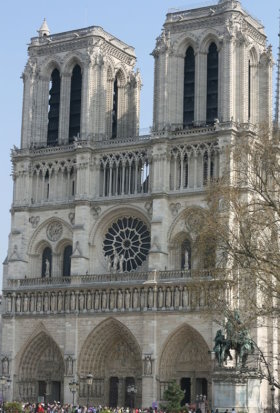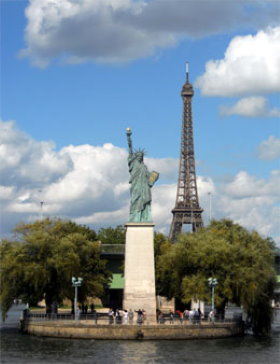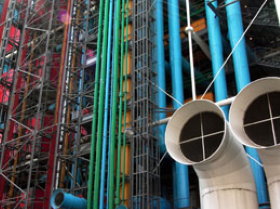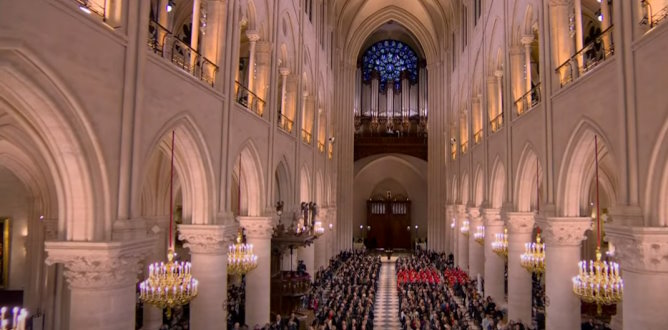Most famous Paris monuments
The five most visited Paris monuments are Notre-Dame, Sacré-Coeur, the Louvre, Versailles Palace and the Eiffel Tower. Notre-Dame is the first of the top ten most visited monuments in Paris. 11 million visitors visited Notre-Dame in a year since its reopening in decembre 2024. The Sacré-Coeur, another famous church, is number two (9). The Louvre, both a palace and a museum, is number three (8.7). The Palace of Versailles close to Paris is number four (8.4). The Eiffel Tower is number five (6.3). Centre Pompidou, now closed fot restoration, was number six (3). The Chapel of the Miraculous medal is number seven (2). Arc de Triomphe is number eight (1.758). Sainte-Chapelle is number nine (1.234). Les Invalides are number ten (1.07). Sightseeing in Paris.

Eiffel Tower

Notre-Dame

Sacré-Coeur

Arc de Triomphe
Sainte-Chapelle

Versailles

Paris churches

Le Panthéon
Fondation Vuitton
La Conciergerie
Les Invalides

Opéra Garnier
Eiffel Tower, the iconic monument
Completed in 1889 for Paris' world exhibition, the Tour Eiffel - Eiffel Tower in English - was designed and built in just two years by 132 workers and 50 engineers. At 300 meters, it remained the world tallest monument until 1930 when the Chrysler Building was completed in New York City.
Due to the addition of a broadcasting aerial at the top in 1957, it is now taller than the Chrysler Building by 5.2 meters and the tallest monument in the city. It is also the world's most visited paid monument. Detailed Eiffel Tower facts.
Visit the Eiffel Tower monument on your own or as part of a guided bus city tour. There are many options.

The Eiffel Tower was build in 1889
Arc de Triomphe and Napoléon
Arc de Triomphe is a famous Paris monument. A legacy of Emperor Napoléon, whose tomb is in Les Invalides, it is the rallying point of French troops parading down the Champs-Elysées on Bastille day, July 14, the French National Day. Arc de Triomphe is a memorial dedicated to the French soldiers who died during WW1. The view from the top of Arc de Triomphe over the twelve radiating avenues from it and the city of Paris is spectacular.

Arc de Triomphe facts: the monument.
Notre-Dame, the Catholic Cathedral
Notre-Dame Cathedral is one of the top Catholic churches from the Middle Ages in Europe. Notre-Dame was built between 1163 and 1270. A pure treasure, Notre-Dame is not just a wonderful monument. Fervent Catholic masses and beautiful concerts give Notre-Dame its full dimensions.
Unfortunately, the fire of April 15th 2019 destroyed significant parts of Notre-Dame Cathedral. After five years of intense restoration work, the fully restored cathedral reopened on December 7 2024.
Notre-Dame is the most visited monument in the city ahead of the Eiffel Tower and Sacré-Coeur Basilica. Many other beautiful Catholic churches are among the best monuments of the city. Visits are free of charge.

Notre-Dame is the Cathedral of Paris
Versailles, the royal palace
If you come to the city for at least two days, visit the Palace of Versailles. Sun King commissioned it in 1668 and had exceptional taste. The famous Hall of Mirrors, the Petit and Grand Trianon, Versailles Gardens, the Grand Canal, are marvels that were imitated many times. It takes half a day to visit Versailles on a coach tour from Paris. Do avoid Tuesdays when the Palace of Versailles is crowded. If you want to go on your own, consider public transport for the Paris to Versailles trip. Palace of Versailles information.

Versailles was commissioned by King Louis XIV
Statue of Liberty, the unexpected monument
The most unexpected monument you can see in Paris is the Statue of Liberty. The original Statue of Liberty in New-York City was a gift from France to America in 1886, designed by Auguste Bartholdi and moulded in Paris.
The main replica of the Statue of Liberty is located in the Ile aux Cygnes, an island within the River Seine, right by the Pont de Grenelle bridge. This bronze statue was inaugurated in 1889, yet its creator absolutely hated the fact that it was facing to the east, and therefore turning her back on America, which was not the purpose of the statue, and definitely not the intentions to keep relations between France and America. However, it was only for the Universal exhibition of 1937 when places such as Palais de Chaillot were constructed, that the statue was actually moved to its current position as though it is facing towards America, just as it was first intented.

The Statue of Liberty on the Seine River
Stay in top Paris hotel

Champs-Elysées hotel
Hôtel Barrière Fouquet's is the only hotel overlooking the Champs-Elysées. This 5-star hotel features a spa with a swimming pool and sauna, 3 bars and 2 restaurants, including the historic Fouquet's brasserie. All rooms have been decorated by top designers. Most rooms offer views of the Champs-Élysées, Avenue George-V or the hotel's interior garden. Champs-Elysées hotels.
Paris 75008 France

Hotel Barriere overlooks Champs-Elysées
Tour of best Paris monuments
A coach tour is a good and fast way to get a glimpse of most famous monuments in the city. We recommend you the full day Paris tour to see Notre-Dame, Louvre, Opéra Garnier, Arc de Triomphe, Invalides, Sacre Coeur and the most famous districts in town: Le Marais, Champs-Elysees and Montmartre. The tour includes a lunch at the Eiffel Tower and a one hour Seine cruise to admire the many monuments along the river banks. Check guided tour details and book.

Napoleon's tomb in Les Invalides
Interesting Paris monuments
The city has many other great monuments. Among them:
Palais de Chaillot, a 1937 must do for its spectacular Eiffel Tower view.
Chapel of our Lady of the Miraculous Medal, a sanctuary to the Virgin attracting two million pilgrims each year.
Hotel de Ville, 19th century Paris City Hall, the replica of the original renaissance building destroyed in 1871
Grande Arche, Opéra Bastille, Stade de France 20th century monuments.
Bibliothèque Nationale de France, the largest contemporary monument.
Paris Mosque, built in the 20th century
Map of Paris monuments

La Grande Arche in La Défense, Paris
Centre Pompidou, a 1977 monument
Centre Pompidou is the most spectacular 20th century monument in Paris. It was designed in 1977 by architects Renzo Piano from Italy and Richard Rodgers from the UK to make art and culture accessible to everyone.
Its factory style architecture contrasts with the surrounding houses of Paris' oldest district between Notre-Dame and Le Marais. Many parisians refer to Centre Pompidou as Beaubourg. Centre Pompidou information.

Rear facade of Centre Pompidou in Paris
Fondation Louis Vuitton
The Fondation Louis Vuitton is the most beautiful monument in the city since the Eiffel Tower. The contemporary pieces of art on display are at pain to match the marvelous building designed by Architect Frank Gehry, a Pritzker prize winner living in Los Angeles. Franck Gehry is most of all known in Europe for the Bilbao Guggenheim Museum.
Inaugurated in October 2014, the Fondation Louis Vuitton instantly became a must see monument in Paris, a city already so rich with palaces, churches and civil architecture.
Created and financed by the LVMH Group (Louis Vuitton, Dior, Guerlain, Moët & Chandon, Hennessy), the Fondation Louis Vuitton encourages and promotes artistic creation both in France and internationally.
Fondation Louis Vuitton information.

Fondation Louis Vuitton
Best monuments near Paris
The Paris region is rich with incredible monuments of the past that you can all easily visit in half a day or a full day from Paris by car or by train. There are also convenient bus tours to Fontainebleau and Vaux Le Vicomte castles. Vaux Le Vicomte is not reachable by train.
Saint-Denis Cathedral (half a day by metro)
Unesco world heritage monuments:
Fontainebleau Castle (half a day to one day)

Fontainebleau Castle is a renaissance castle
Paris monuments escaped destruction in 1944
Many of the monuments of Paris could have been distroyed in 1944 with the liberation of the city. Hitler had no intention of preserving the city, nor of declaring it open, like Rome in June 1944. General von Choltitz, the last military governor of occupied Paris, received orders without nuance, including that of August 22: "Paris is to be transformed into a heap of ruins. The general must defend the city to the last man and will perish if necessary under the rubble." Why then were the capital and its monuments spared? Von Choltitz did not follow his Führer's orders. The general did not see the logic of such destruction. The Battle of Normandy was lost, the German troops fell back, the meager stationed contingents evacuated the city. Ravaging the capital would have been costly in human lives, including German ones, unnecessary from a military point of view and hindering the movement of the Reich soldiers withdrawing from Normandy.
In addition, the Swedish consul Raoul Nordling would have convinced on the night of August 24 to August 25 the German general to give up destroying the monuments and the bridges. The Allies, worried about the destruction of the city, also warned von Choltitz. On August 24, they handed von Choltitz a letter threatening him to be brought before a war tribunal. The German governor no doubt finally had concern for his own posterity: he who had participated in the destruction of Rotterdam and Sevastopol, in the extermination of the Jews on the Eastern Front, could pose as the savior of Paris.
